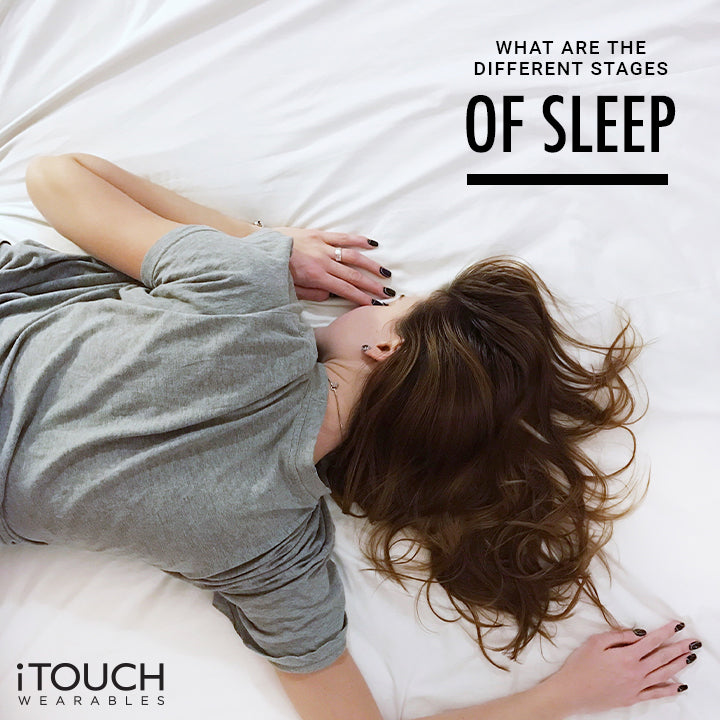
What Are The Different Stages of Sleep?
Are you getting enough sleep? And more importantly, are you spending enough time asleep in each phase? Not many people know the different stages of sleep, which could result in waking up tired or cranky. Keep reading to learn about the importance of each stage and how you can monitor them.
Stages of Sleep

There are four stages of sleep: Non-REM (NREM) sleep which include stages 1, 2 & 3, and then REM sleep which stands for rapid eye movement. Then of course, periods of wakefulness occur before and throughout the various sleep stages or as one shifts sleeping position. These stages progress cyclically from 1 through REM then begin again with stage 1. Each of these sleep stages serve a different purpose, so understanding how much of each stage you go through can help you identify and address sleep-related issues. And just keep track of your sleep in general if you were ever curious!
Stage 1: This is the lightest stage of NREM sleep, also known as the drowsy sleep stage. You’re still hearing things and have a sense of awareness, therefore you can be easily disrupted and awakened. However, your body is starting to relax and brain wave activity begins to slow down.
Stage 2: This is the first actual stage of defined NREM sleep, otherwise known as light sleep. Your brain waves continue to slow down with specific bursts of rapid activity known as sleep spindles and K. Both of these are thought to serve as protection for the brain from awakening from sleep. Additionally, your body temperature, breathing, and heart rate begin to slow down.
Light sleep is very important because it takes up more than half of the night, while covering a lot of body maintenance. This is when your body processes memories and emotions and your metabolism regulates itself.
Stage 3: Now we move into deep sleep. This is the most restorative stage of sleep, as your breathing slows, muscles relax, and your heart rate becomes more regular. You'll become less responsive to outside stimuli, but you're more likely to sleep talk, sleep walk, and have night terrors during this stage.
Deep sleep is very much about the body, as the thinking parts of the brain are turned off. You’re not dreaming at all during this time. Your body is doing a lot of rebuilding and repairing with growth, along with strengthening your immune system.
REM: This is the dreaming stage, as brain waves and eye movements are rapid and your body is inactive. You don't want to be woken in this phase, for it will leave you feeling groggy or overly sleepy. REM is also very important for emotion regulation and memory. You’re clearing the brain of things that aren’t needed, and keeping many processes in the body working properly.
If you cut your sleep short, most of what you’re cutting out is REM. Similar to above, too little REM sleep can leave you feeling groggy, less able to focus, and can possibly lead to memory problems. On the flip side, consistently getting too much REM could also create problems. This can include too much brain activation, which can leave you angry, irritable, depressed, or anxious.
Normal Sleep Cycle

A complete sleep cycle takes an average of 90 to 110 minutes, with each stage lasting between 5 to 15 minutes. The first sleep cycle of the night has a relatively short REM sleep and long periods of deep sleep. However later in the night, REM periods lengthen and deep sleep time decreases. Still, your body doesn’t just hit each sleep stage once a night, nor does it spend an equal amount of time in each of them. It cycles through all of these stages multiple times a night, which is what is tracked.
On average, light sleep will take up about 50 to 60 percent or more of your night, deep sleep is likely to take up 10 to 25 percent, and REM makes up about 20 to 25 percent of your nightly sleep. Be sure to compare your results to see if you're getting a good night's rest.
Monitor Your Sleep

The easiest way to keep track of your sleep pattern is through a smartwatch. Lucky for you, all of iTOUCH Wearable products (such as our fitness trackers and smartwatches) include a sleep monitor to track the quality of your sleep. By wearing your smartwatch while you sleep, you are tapping into your nighttime heart rate and movement patterns. Thus, your device will be able to estimate how much time you spend in light, deep, and rapid eye movement (REM) sleep.
Share your take on the stages of sleep and how you monitor it by tagging us on Instagram @itouchwearables and Facebook @itouchwearables. Also, be sure to check out our new articles published daily!
-Gina


